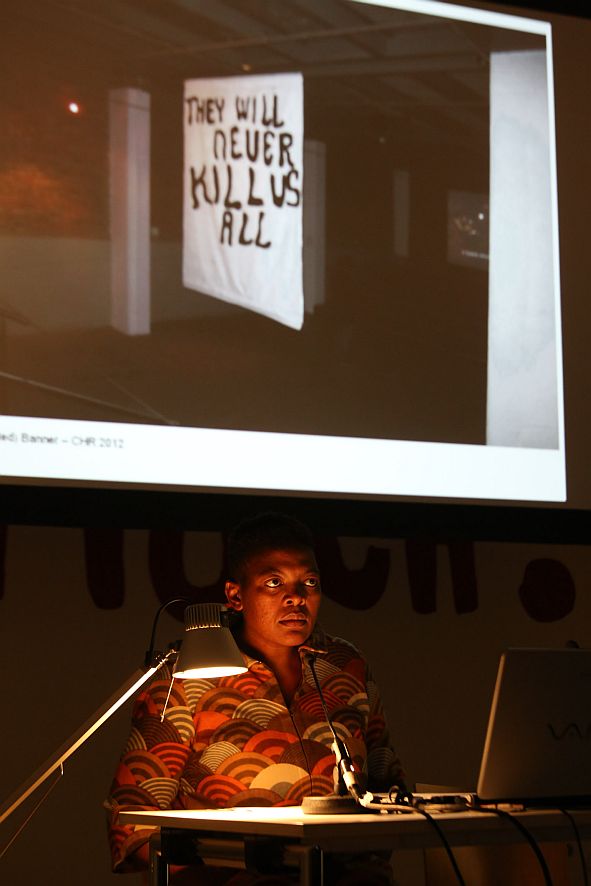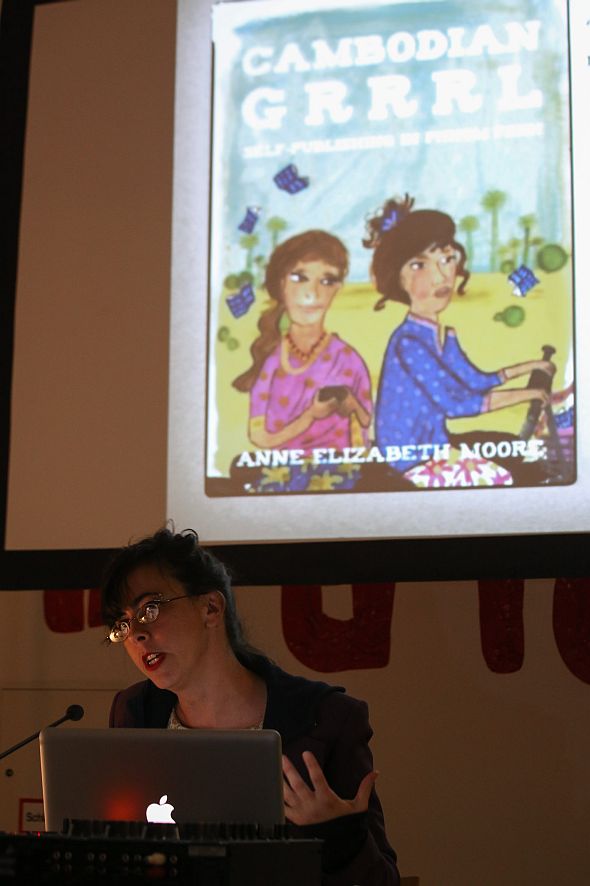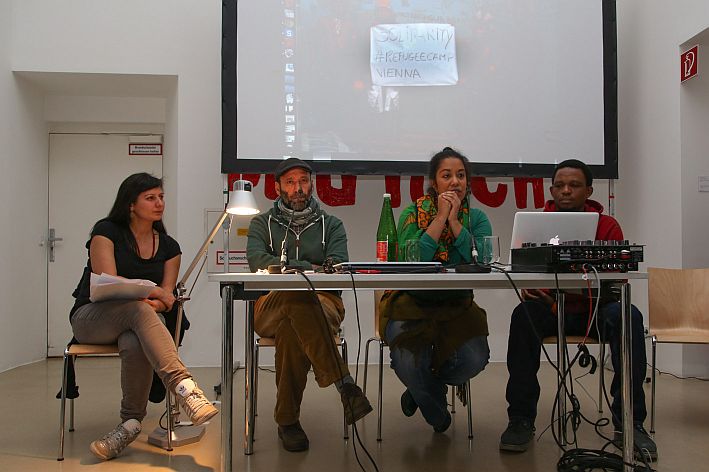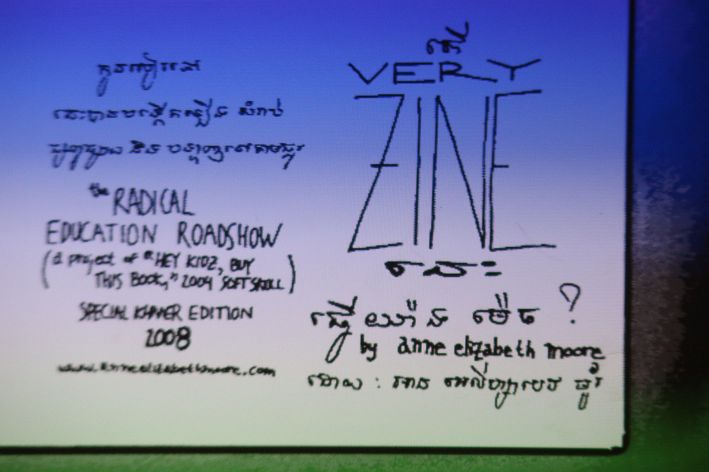Gespräch: Vulnerability and Resistance
Vulnerability and Resistance
Discussion about Public Art
January 30, 2014, 4 p.m.
In the Kunstraum Niederoesterreich
Participants:
Pelin Tan, Mardin, Turkey
Pelin Tan is a sociologist whose fields of interest include urban zones of conflict, territorial politics, and working conditions. She works with a wide range of different forms of research and implementation (for example, in her research project Institutions by Artists in collaboration with Anton Vidokle). She currently teaches architecture at the Artuklu University in Mardin, Turkey. She has published a number of books, including With/Without Spatial Politics in The Middle East (2007) and Recht auf Stadt (2011). She has been the editor of several magazines (including ArtMargin), and she also works as a journalist. She will talk about the events in and around the Gezi Park in Istanbul and the Silent University. http://tanpelin.blogspot.co.at... and http://thesilentuniversity.org...
Rachel Susan Garfield, London, UK
Ethnicity, ideology, post colonialism, identity politics, and Jewish identity are key elements in Rachel Garfield’s artistic practice. She often addresses these issues in her cinematic works based on a montage technique and in her publications and lectures. She will show a sequence from her film The Straggle (2012), in which she presents the lives of people who grew up in politically active families and juxtaposes their stories and everyday lives with propaganda material. http://www.rachelgarfield.com/...
Anne Elizabeth Moore, Chicago, USA
Anne Elizabeth Moore is an artist, Fulbright Scholar, and UN Press Fellow who explores the themes of youth, gender, new media, and the global textile trade. In addition to numerous award-winning publications, she published the book Hip Hop Apsara: Ghosts Past and Present, in which she explores the radical economic changes in Cambodia in a poetic way. She currently lives in Cambodia, where she is collaborating with local women on the project Garment Work, which she will present here. http://anneelizabethmoore.com/
Gabi Ngcobo, Johannesburg, South Africa
Gabi Ngcobo is a curator, teacher, and the artistic director of the Center for Historical Reenactments. She also teaches at the Wits School of Arts of the University of Witswatersrand in Johannesburg, and she co-founded the Visual Arts Network of South Africa (VANSA). In 2010, she co-curated the exhibition rope-a-dope: to win a losing war in Cabinet, New York, and she helped to mentor the project Xenoglossia, a research project, which was also presented at the 11th Lyon Biennale. She will talk about the work done by the Center for Historical Reenactments and its future (it was dissolved in 2012). http://centerforhistoricalreen...
Marias Lôbo, Vienna, Austria
Marias Lôbo is an artist and activist in the black and migrant movement. For more than a year now, she has been working together with the Refugees Protest Camp Vienna, which whom she has realized a number of projects, like Eating Europe (Rebelodrom; http://rebelodrom.blogspot.co) and Manifesto Antropófago. http://de.wikipedia.org/wiki/R...
She will talk about her work together with Khan Adalat and Clifford Erinmwionghae, two activists from the Refugees Protest Camp Vienna.
Elke Krasny
Elke Krasny is a cultural theorist, a senior lecturer at the Academy of Fine Arts Vienna, and a visiting professor of Urban Culture and Public Space (SKuOR) at the Vienna University of Technology. She has also been a guest curator for the Hong Kong Community Museum Project and a visiting scholar at the Canadian Center for Architecture in Montréal in 2012. The exhibition Hands-on Urbanism 1850-2012. The Right to Green, which she curated, was shown in 2012 in the Architekturzentrum Vienna and the Venice Biennale of Architecture. Her book Urbanografien. Stadtforschung in Kunst, Architektur und Theorie, written together with Irene Nierhaus, was published in 2008. She conceived and edited the book Women's: Museum. Curatorial Politics in Feminism, Education, History, and Art, which was published in 2013.
Discussion about Public Art
January 30, 2014, 4 p.m.
In the Kunstraum Niederoesterreich
Participants:
Pelin Tan, Mardin, Turkey
Pelin Tan is a sociologist whose fields of interest include urban zones of conflict, territorial politics, and working conditions. She works with a wide range of different forms of research and implementation (for example, in her research project Institutions by Artists in collaboration with Anton Vidokle). She currently teaches architecture at the Artuklu University in Mardin, Turkey. She has published a number of books, including With/Without Spatial Politics in The Middle East (2007) and Recht auf Stadt (2011). She has been the editor of several magazines (including ArtMargin), and she also works as a journalist. She will talk about the events in and around the Gezi Park in Istanbul and the Silent University. http://tanpelin.blogspot.co.at... and http://thesilentuniversity.org...
Rachel Susan Garfield, London, UK
Ethnicity, ideology, post colonialism, identity politics, and Jewish identity are key elements in Rachel Garfield’s artistic practice. She often addresses these issues in her cinematic works based on a montage technique and in her publications and lectures. She will show a sequence from her film The Straggle (2012), in which she presents the lives of people who grew up in politically active families and juxtaposes their stories and everyday lives with propaganda material. http://www.rachelgarfield.com/...
Anne Elizabeth Moore, Chicago, USA
Anne Elizabeth Moore is an artist, Fulbright Scholar, and UN Press Fellow who explores the themes of youth, gender, new media, and the global textile trade. In addition to numerous award-winning publications, she published the book Hip Hop Apsara: Ghosts Past and Present, in which she explores the radical economic changes in Cambodia in a poetic way. She currently lives in Cambodia, where she is collaborating with local women on the project Garment Work, which she will present here. http://anneelizabethmoore.com/
Gabi Ngcobo, Johannesburg, South Africa
Gabi Ngcobo is a curator, teacher, and the artistic director of the Center for Historical Reenactments. She also teaches at the Wits School of Arts of the University of Witswatersrand in Johannesburg, and she co-founded the Visual Arts Network of South Africa (VANSA). In 2010, she co-curated the exhibition rope-a-dope: to win a losing war in Cabinet, New York, and she helped to mentor the project Xenoglossia, a research project, which was also presented at the 11th Lyon Biennale. She will talk about the work done by the Center for Historical Reenactments and its future (it was dissolved in 2012). http://centerforhistoricalreen...
Marias Lôbo, Vienna, Austria
Marias Lôbo is an artist and activist in the black and migrant movement. For more than a year now, she has been working together with the Refugees Protest Camp Vienna, which whom she has realized a number of projects, like Eating Europe (Rebelodrom; http://rebelodrom.blogspot.co) and Manifesto Antropófago. http://de.wikipedia.org/wiki/R...
She will talk about her work together with Khan Adalat and Clifford Erinmwionghae, two activists from the Refugees Protest Camp Vienna.
Elke Krasny
Elke Krasny is a cultural theorist, a senior lecturer at the Academy of Fine Arts Vienna, and a visiting professor of Urban Culture and Public Space (SKuOR) at the Vienna University of Technology. She has also been a guest curator for the Hong Kong Community Museum Project and a visiting scholar at the Canadian Center for Architecture in Montréal in 2012. The exhibition Hands-on Urbanism 1850-2012. The Right to Green, which she curated, was shown in 2012 in the Architekturzentrum Vienna and the Venice Biennale of Architecture. Her book Urbanografien. Stadtforschung in Kunst, Architektur und Theorie, written together with Irene Nierhaus, was published in 2008. She conceived and edited the book Women's: Museum. Curatorial Politics in Feminism, Education, History, and Art, which was published in 2013.
"Vulnerability and Resistance: The Public Dis/Appearance of Bodies"
Talks and discussion about Doing Art in the Public Realm
Conceived and chaired by Elke Krasny
In 2013, the cultural theorist Elke Krasny chaired an international discussion with the title “How to Identify with Difference” in the context of the series Discussions about Public Art. The participants and the audience discussed how distinct ideas about history can be created or visualized with the help of artistic strategies. Due to the urgency and complexity of this issue, Krasny was invited back to explore this theme further.

This year’s symposium focuses on the importance of the body – its mental and physical strength, and its vulnerability – as a fundamental part of resistance. Physical presence alone can be a form of resistance: We only have to think of the images of protestors just standing in the streets of Istanbul. At the same time, the forceful clearing of Taksim Square during previous protests show how the state authorities attack the body in a very concrete sense. In the last few years, forms of public resistance against social conditions have been on the rise again and are now involving broader segments of the population. While new virtual channels of perpetuation and agitation have opened up through social media, resistance is still primarily expressed through the body – whether in the already mentioned "Silent Protest" in Istanbul, the refugee protest by Camp Vienna in the Votiv Church, or the attention-grabbing interventions by FEMEN activists. To what degree do these current events define forms of activism? What spaces do societies provide for activists’ actions, or what paths do activists have to make for themselves? Where and how can we establish alternative fields of action and command public attention? Elke Krasny and the other speakers will discuss forms of taking artistic action and making intellectual interventions in contemporary contexts – in other words, in continuously changing public spaces. What forms of collaboration between visual art, activism, and theory are possible? How can alliances be formed between artists and non-artists? How can we raise the awareness of each other in the respective camps?
The invited speakers will present their positions based on different geographic, artistic, cultural, and theoretical references. Because each of them addresses the categories of agency/power, the public "space of appearance" (Erscheinungsraum), vulnerability, and resistance in their practice in different ways, through their talks and the following discussion they generate a transnational space for the production of knowledge.




Fotos © eSeL.at
Talks and discussion about Doing Art in the Public Realm
Conceived and chaired by Elke Krasny
In 2013, the cultural theorist Elke Krasny chaired an international discussion with the title “How to Identify with Difference” in the context of the series Discussions about Public Art. The participants and the audience discussed how distinct ideas about history can be created or visualized with the help of artistic strategies. Due to the urgency and complexity of this issue, Krasny was invited back to explore this theme further.
This year’s symposium focuses on the importance of the body – its mental and physical strength, and its vulnerability – as a fundamental part of resistance. Physical presence alone can be a form of resistance: We only have to think of the images of protestors just standing in the streets of Istanbul. At the same time, the forceful clearing of Taksim Square during previous protests show how the state authorities attack the body in a very concrete sense. In the last few years, forms of public resistance against social conditions have been on the rise again and are now involving broader segments of the population. While new virtual channels of perpetuation and agitation have opened up through social media, resistance is still primarily expressed through the body – whether in the already mentioned "Silent Protest" in Istanbul, the refugee protest by Camp Vienna in the Votiv Church, or the attention-grabbing interventions by FEMEN activists. To what degree do these current events define forms of activism? What spaces do societies provide for activists’ actions, or what paths do activists have to make for themselves? Where and how can we establish alternative fields of action and command public attention? Elke Krasny and the other speakers will discuss forms of taking artistic action and making intellectual interventions in contemporary contexts – in other words, in continuously changing public spaces. What forms of collaboration between visual art, activism, and theory are possible? How can alliances be formed between artists and non-artists? How can we raise the awareness of each other in the respective camps?
The invited speakers will present their positions based on different geographic, artistic, cultural, and theoretical references. Because each of them addresses the categories of agency/power, the public "space of appearance" (Erscheinungsraum), vulnerability, and resistance in their practice in different ways, through their talks and the following discussion they generate a transnational space for the production of knowledge.




Fotos © eSeL.at

